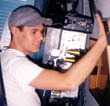|
|
This topic comprises 3 pages: 1 2 3
|
|
Author
|
Topic: Xenon Bulbs Exploding after about 1200 Hours
|
|
|
|
|
Andrew Duggan
Expert Film Handler

Posts: 127
From: Albany, NY, USA
Registered: Jun 2002
|
 posted 06-11-2003 03:53 AM
posted 06-11-2003 03:53 AM





Hey Cary. Do you have any more information about this problem that you can provide? What kind of lamphouses and power supplies are being used? What kind of bulbs were these, both manufacturer and power rating (1600 watts, 2000 watts, etc.)? Did you take any actions since then, like opening the lamphouse with a multimeter to check and see if maybe you're running too much power to the bulb(s)? Any more info you can throw out there will probably help a lot in figuring out the problem.
It's a bit of a shot in the dark right now, but I'm going to go out on a limb and say that either
A)You are running too much current to the bulb (you should open up your lamphouse and test this manually with a decent ammeter, since many of the built-in meters on lamphouses are notorious for being horribly, terribly wrong....Lumex...I am looking in your direction...) or
B) The ventilation on your lamphouses is inadequate (Another baleful stare at Lumex...).
These are both easy problems to remedy, but like I said they are both just blind assumptions, and as we all know, assumption is the mother of all f*ckups...
Hope this helps a bit.
| IP: Logged
|
|
|
|
|
|
|
|
|
|
|
|
|
|
|
|
|
|
|
|
|
|
Scott Norwood
Film God

Posts: 8146
From: Boston, MA. USA (1774.21 miles northeast of Dallas)
Registered: Jun 99
|
 posted 09-05-2003 07:03 AM
posted 09-05-2003 07:03 AM





I just had my first bulb explosion last night. It was more of a "crash" (like a big plate glass window breaking) than a "boom." This was one of our kick-ass (not) LTI 2000 W/H bulbs--running at 75 amps and with a whopping (not) 1200 or so hours--in a Strong Highlight II lamphouse, and it happened mid-show. I was maybe twenty feet away (working at the rewind bench) when it happened.
The explosion was violent enough to crack the green window in the shutter guard (Simplex X-L PR1014 projector). It also caused visible damage to the (metal) reflector and left bits of quartz all of the lamphouse and shutter guard area of the projector.
The weird thing is that the positive (anode?) end of the dead lamp almost looked burned--not melted. Not sure if this happened as a result of the explosion or if it caused it. There wasn't any visible damage or charring to other parts of the bulb, and all connections appeared to be tight.
Obviously, we'll be sending the bulb (what's left of it, anyway) back to LTI to see what they say, but my current thinking is that this was a defective bulb. The lamphouse/rectifier is fairly new (five years old) and we were getting 4000+ hours with Osram bulbs and 2500 or so hours with LTI bulbs. I suppose that the ammeter might be defective, but that seems unlikely given the lifetimes that we were seeing with other bulbs and given that we have never run 2k bulbs at more than 80 amps.
We lost the rest of that show (platter house with one machine per screen), but the second show (with new LTI bulb) ran fine, and the damaged reflector didn't seem to affect image quality.
As a side note: are there any automation systems which use a photocell (or other device) inside the lamphouse and will kill the show if there is no light? If there hadn't been someone in the booth when this happened, the audience could easily have been left sitting in the dark until someone complained to an usher.
| IP: Logged
|
|
|
|
|
|
All times are Central (GMT -6:00)
|
This topic comprises 3 pages: 1 2 3
|
Powered by Infopop Corporation
UBB.classicTM
6.3.1.2
The Film-Tech Forums are designed for various members related to the cinema industry to express their opinions, viewpoints and testimonials on various products, services and events based upon speculation, personal knowledge and factual information through use, therefore all views represented here allow no liability upon the publishers of this web site and the owners of said views assume no liability for any ill will resulting from these postings. The posts made here are for educational as well as entertainment purposes and as such anyone viewing this portion of the website must accept these views as statements of the author of that opinion
and agrees to release the authors from any and all liability.
|

 Home
Home
 Products
Products
 Store
Store
 Forum
Forum
 Warehouse
Warehouse
 Contact Us
Contact Us




 Printer-friendly view of this topic
Printer-friendly view of this topic











![[Smile]](smile.gif)



![[Eek!]](eek.gif)

![[bs]](graemlins/bs.gif) - which blew up in the lamphouse somewhere between 800 and 1000 hours, whereas the Osram was at 5000+ hours when it got swapped out.
- which blew up in the lamphouse somewhere between 800 and 1000 hours, whereas the Osram was at 5000+ hours when it got swapped out. ![[Roll Eyes]](rolleyes.gif)




